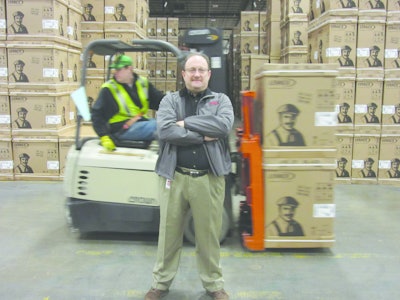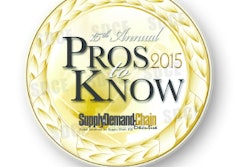
Supply chain is in constant flux. It twists and turns and evolves seemingly on a daily basis. To keep up with that movement takes thought, vision and action. End-users and consumers demand on-time service or they’ll go elsewhere. It takes an efficient supply chain to meet those demands. Each year the staff of Supply & Demand Chain Executive sifts through hundreds of entries to find the best and brightest in supply chain: The Supply & Demand Chain Executive Pros to Know.
Once those executives are selected, the job gets even tougher as we must anoint our Pro to Know of the Year. The committee first narrowed the field to four exceptional supply chain practitioners, then, at last, we named our winner: Keith Nash, Vice President Supply Chain Logistics for Lennox Residential Heating and Cooling. The worthy finalists were Celeste Aarons-Jenkins, Vice President, Demand Planning, Tiffany’s & Co., David Medlin, Senior Direct, Distribution Systems, Target Corp., and John P. Willi, Vice President, Corporate Supply Chain Management, NYU Langone, Medical Center.
Lennox Industries provides climate control products for residential and commercial heating, ventilation, air conditioning, and refrigeration markets around the world. The company’s customers are dealers who work directly with the end-user consumers and install units in their homes. These dealers want to be able to visit their clients’ homes after typical 9-5 work hours, and still guarantee next day installation. “Lennox is seeing more orders placed later in the day, with the same expectation for next day delivery,” Nash says. “Order cut-off times, which used to be around 3 p.m. now are received as late as 10 p.m., and deliveries are scheduled for as early as 6 a.m. the next morning.” Meeting these decreasing cycle times and increased service levels at a lower cost and working capital is the biggest supply chain challenge that Lennox currently faces.
One solution that Nash and his team developed was moving from a national stocking design based on two large warehouses and 65 stores to a hub and spoke network with eight regional distribution centers, 20 local distribution centers and 160 stores (with plans to reach 215), of which 51 are shipping locations. Lennox used Manhattan Associates’ Warehouse Management System (WMS) and Transportation Management System (TMS) to manage the added complexity that came from that move, which necessitated going from one shipping location to 51 as well as fielding inbound orders from more than 160 internal locations, and more than 7,000 external delivery locations. The WMS and TMS software manages that complexity seamlessly, replacing the need for an additional 200 plus workers.
Under Nash’s Supply Chain Leadership Management team—Gary Bedard, Corey Larsen, Tim Wismer , Rich Wroclawski , Mark Johnson, Ross Angell, John Ernat, Kathryn Manders, Keith Barnes, John Beckett, Karen Schuller, Von Reynolds and, Laura Dahlberg—the move to this hub and spoke network has enabled Lennox to be geographically closer to its customers, which helps the company cater to shorter order cycles. After implementing Manhattan’s WMS, Lennox saw warehouse productivity increase by 24.5 percent. Logistics as a percent of sales has decreased 19.6 percent. Lennox also re-implemented SAP demand planning and forecast software, which has helped the company boost on-time delivery rates from below 80 percent to almost 95 percent. In the year to come, Nash and his team will be working with Manhattan Associates to implement customer self-service options as well, which will facilitate order placement and tracking and will be available on mobile devices. Self-service options will put more power and control in the hands of Lennox’s customers and will streamline processes.
Under his leadership, Lennox also has begun investing heavily in employee education, requiring 40 hours of training for non-managers and 60 hours of training for managers. Courses focus on general management and supply chain education. Internal education funding didn’t exist before Nash joined Lennox in 2010, but since then he has helped carve out a six-figure employee education budget. This program has been integral in preparing employees to execute the safest, most effective supply chain operations possible, as well as better meet the demands and tight timeframes of their customers.
Nash also says he shares this honor with Lennox’s Supply Chain Distribution Operations Leadership: Bud Price, Tom Wainwright , Clif Turner, Mike Gleason and Derek Barnhill.
Our three finalists also made a difference for their companies. An iconic brand, Tiffany’s & Co., wants to expand its global presence. Celeste Aarons-Jenkins and the Demand Planning team is charged with balancing support for marketing campaigns, new product launches, and strategic corporate initiatives while accelerating inventory turns and improving service levels.
One of the key programs the Demand Planning team initiated this past year was to review the forecasting process to improve accuracy and product availability. Taking a step back, Aarons-Jenkins and her team identified two key areas for improvement: understanding bias, and the impact of new product launches. Reviewing historical data, the team recognized that bias influenced prior forecasts, which led to excess inventory. Additionally, the team identified an opportunity for improvement around new product launches. Traditionally, a demand plan for new product would include only a small amount of “cannibalization” of other collections. To increase success, the demand planning team created a holistic forecast that now accounts for several variables, including the impact of new product launches on (or in combination with) other business segments.
Stakeholders from marketing, design and product development, assortment planning, supply planning, internal manufacturing, the gemstone/diamond division, and creative visual merchandising are all involved in the planning process. This collaborative effort will continue to be enhanced as the company moves towards a more formal integrated business planning process. Tiffany & Co.’s demand planning team relies on Logility Voyager Solutions to drive its demand forecast, which is translated into its purchase, inventory, and replenishment allocation plans. In addition, the team has been able to focus on more strategic initiatives to drive additional supply chain opportunities.
Dave Medlin of Target asks, “How should a company balance product, experience, value, personalization, etc.? We know our guests expect great design and quality products from us, but they also demand great value. But we know that we can’t be all things to all consumers, so we have to prioritize and are focusing our efforts in key categories where know we can excel and differentiate ourselves. These decisions have huge supply chain ramifications as we think about balancing the capacity cost to carry and ship inventory with the need to fill guest demand as quickly as possible. This requires a thoughtful blend of supply chain insight and supply chain execution.”
To provide the customer with a seamless experience means unlocking new fulfillment options in the supply chain, such as Pick up in Store or Ship from Store, allowing Target to leverage existing assets in new ways that provide value and enhance guest experience. “We are currently seeing over 10 percent of our digital transactions being picked up in stores, and the best part is that nearly a quarter of those guests who come to pick up increase their basket size once they are in the store. Win, win!”
John Willi is responsible for $2 billion of spend at New York University Hospitals Center & Medical School. The SCM Team utilizes value-based management techniques, including gateway pricing, with a total-cost-of-ownership focus with strategic suppliers to achieve $3.5 million in annual savings in Orthopedics, CRM and Neurosurgery spend area. The SCM Team considers their strategic suppliers as true business partners and integrates product road mapping sessions to drive enterprise wide solutions. This SCM collaborative style has yielded over $19 million in additional annual savings which resulted in an increase in bottom line contribution margin of 3 percent.
To accomplish this, he says, the health care industry must adopt world-class practices from out of industry. Predictive analytics and sales and operations planning must be integrated into patient care along with demand planning. “That means an integrated approach with our supply chain is critical in the design and production of improved healthcare. Transparency and trust must be built between practitioners and suppliers in order to optimize results,” Willi says. “Supply chain strategy and corporate strategy are very much aligned. Supply Chain leadership must have a "seat at the table" in the C-suite to convey the value proposition. If your supply chain is not aligned with your corporate mission you will be setup for failure. You must be focused on one mission and execute on it.”
And now, let’s pay tribute to all of our 2015 Pros to Know.
PROVIDER PROS
Stephanie Miles, Senior VP Commerical Services, Amber Road. Miles has a deep understanding of industry best practices and potential risk areas. She also led the formation of best practices for data management through customer forums and industry discussions. She helps customers understand how to best manage a sea of diverse of data.
Nathan Pieri, Chief Product Officer, Amber Road. His broad set of experience in enterprise software, manufacturing operations, product engineering, trade content and supply chain analysis has given Pieri a deep understanding of the needs of the customer and how technology can help improve the management and operations of complex global supply chains.
James Marland, VP Network Growth, Ariba, an SAP Company. Supply chain can be a catalyst in a broader “Get Connected” strategy, Marland says. “As Supply Chain proves out the benefits of collaboration with suppliers, the same kind of networks can be used by treasury to manage cash or transmit payments, or by sales to find new customers and increase wallet share from existing customers.”
Gene Averill, President and CEO, Avercast. Averill believes web-based forecasting, planning and collaboration tools are crucial in transcending language barriers, time zones and culture-specific challenges. Sharing supply chain data across the end-to-end supply chain allows every trading partner to shorten lead times, improve customer service levels, inventory turns and the overall bottom-line.
Joe Averill, CIO, Avercast. One of today’s largest challenges, he says, is harnessing big data for supply chain optimization, particularly Point of Sale (POS) data. Averill developed the capability to load and process hundreds of millions of POS records into a single SQL database and perform analysis in seconds to minutes as opposed to previous industry standards.
Martin Jack, CTO, Barcoding, Inc. For a large equipment rental company, Jack and his team brought together the various vendors that provide different technologies—GPS, handheld computers, route accounting software, etc.—to create a single, integrated solution. The customer has experienced more efficient fleet management, improved customer service, minimized verbal communications, increased driver safety, optimized routes, and more.
Esa Tihilä, CEO, Basware. Under Tihilä’s direction Basware recently established Basware Financing Services, which delivers new and innovative financing services for buyers and suppliers, combining payment with financing services. These solutions will help businesses automate their financial processes, manage their cash positions more intelligently, build stronger relationships across their supply chains and ensure they can pay and be paid quickly and efficiently.
Dawn Anderson, Planning Process Manager, Baxter Planning Systems. Improving service level while simultaneously reducing or maintaining inventory cost is the primary challenge in managing a supply chain. To achieve this, Anderson implements best practices for evaluating analytics that assess the root cause of each service “miss” in the supply chain. These metrics have been instrumental in facilitating the continuous improvement required to maintain high service levels while controlling inventory cost.
Chris Heywood, Lead Planner, Baxter Planning Systems. Heywood says that by understanding the requirements of the service supply chain, companies can implement the tools and processes needed to ensure that parts are available on today’s aggressive service level agreements. This must be done while controlling the total cost of inventory and mitigating creation of excess or obsolete inventory.
Lisa Primrose, Director, Client Services, Baxter Planning Systems. By working with a large automotive manufacturer to create and align the organization around a common set of metrics, Lisa’s direction around the adoption of best practices enabled them to achieve a 20 percent improvement in service level while keeping inventory days of supply steady.
Rod Daugherty, VP Product Strategy, Blue Ridge. Daugherty believes supply chain planning and execution must be central to a company’s overall strategy. If done strategically, the broad spectrum of supply chain positively affects both the top and bottom line starting with the proper forecast and profitable inventory plan through the efficient and cost saving execution of transportation and inventory distribution.
John Moffitt, VP Services, Blue Ridge. Working with retailers and the Blue Ridge solution set, Moffitt is helping develop and implement solutions that will improve the flexibility of supply chains and properly forecast where demand will be generated and by which customers, in order to be sure inventory is deployed in the most effective way.
Greg White, CEO, Blue Ridge. To reap the full benefit of supply chain optimization initiatives, White says, they should involve more than just logistics and supply chain. By understanding consumer activity, analytics create actionable intelligence that can affect the decision-making of finance teams, category managers, sales and marketing leaders and, especially, the executive suite. Sharing these insights drives significant results to the bottom line.
Colby Beland, VP of Sales & Marketing, CaseStack, Inc. Beland was responsible for assembling a team of Business Development Executives who for the last three years have produced Y-O-Y growth of more than 26 percent. They expect to achieve similar or higher results in 2015. Beland gives all the credit to his team and their ability to continually create valuable supply chain solutions for CaseStack’s customers.
Erwin Hermans, Vice President, Supply Chain Managed Services, Celestica. Hermans brought to market a complete managed services business model that delivers the tools to create predictability, reliability, execution and responsiveness across the entire supply chain.
Dave Lindeen, Senior VP of Sales, Corcentric. Lindeen has long understood that what goes on “behind the scenes” is a vital part of making the entire supply chain function at its highest level. To this end, he has worked closely with procurement professionals and their suppliers to accelerate and ensure accuracy in the entire procure-to-pay process. His involvement has given supply chain executives the freedom to focus on more strategic issues, confident that all necessary information, data, and payments are communicated between parties.
Bill Harrison, President, Demand Solutions. Rather than simply focusing on the knowledge and data of your own company, Harrison advises, you can add external input and visibility into all your planning processes. You can help your network react more quickly by sharing data from your customers with supply chain partners.
T. Grant Dearborn, VP, Denali Group. He is currently spearheading the formal development of Denali Technology Services – a new offering for Denali Group – for which he is the program architect. Through Denali Technology Services, Grant is leading procurement organizations through the phases of procurement transformation, which more often centers on the evolution of procurement technology.
Steve Schuman, Chief Procurement Officer, dg3. As the senior executive in charge of $1.2 billion corporate and divisional purchasing and operations, Schuman has overall responsibility for defining and implementing strategic sourcing decisions and built a worldwide business strategy. He has delivered savings in excess of $100 million by developing a strategic methodology and carrying out tactical objectives with win-win purposeful objectives.
Peter Edlund, Senior VP of Global Marketing, DiCentral. Over the past 14 years, Edlund, a founding member of DiCentral, has helped transform the firm from a small EDI company to a robust supply chain solution provider with a global presence. The greatest challenge facing customers today, he says, is meeting and exceeding their demands for collaboration in the supply chain. Companies are struggling to effectively collaborate with their business partners, both large and small, but those that choose this route become rapidly scalable and able to accommodate their customers’ ongoing B2B integration requirements with relative ease. This, in turn allows them to focus on other critical supply chain items like sourcing and transport.
Thuy Mai, Founder and CEO, DiCentral. A good supply chain is comprised of tools that provide speed, efficiency and flexibility. Companies of all sizes need these tools to achieve and enjoy the best supply chain. From Mai’s perspective and an EDI standpoint—DiCentral develops these tools to enable its clients to act quickly with increased insight, efficiency, and flexibility. So it’s a matter of developing the right tools for the right companies that do the right job at the right time. And that is what Mai and his team strives to do to ensure the best possible supply chain experience for clients.
Ann Drake, CEO, DSC Logistics. Under her leadership, the culture of DSC encourages critical thinking and innovation; values creativity, courage and collaboration; promotes leadership among employees of all levels; and provides senior leaders with challenges and opportunities to build and utilize key strengths. She says, “the world is discovering the supply chain—and discovering the value of partnerships and collaboration.”
Geoff Annesley, General Manager, Semiconductor, E2open. Every company is trying to improve quality and reduce costs, which has been the same mantra for the last 40 years. But, many companies keep making the same mistake, Annesley says, making it next to impossible to achieve this objective. They build their supply chain without thinking about suppliers. As a result of this one-sided approach, there’s a major disconnect between the customers and their suppliers, and they’re simply out of sync. Overcoming this hurdle means having the right tool in place to bring both of these key players into alignment or processes won’t be manufacturing-friendly.
Pawan Joshi, VP Strategy, E2open. Throughout his career, Joshi has helped companies deploy innovative supply chain models and leverage technology to support them. By utilizing his product and technology experience and his supply chain training, he is extremely effective at bringing IT and operations teams together to address complex supply chain needs and develop a roadmap for continuous innovation. He has worked in diverse industries with companies like Avon, Celestica, Seagate, Vodafone, IBM, Lenovo, HP, Motorola Solutions, and Cisco, and excels at engaging with customers and prospects and quickly diagnosing both the challenges and opportunities in their supply chains.
Steve Lykken, VP of Customer Solutions, E2open. With a wealth of knowledge in supply chain management, Lykken has the ability to quickly identify the crux of a complex problem and formulate pragmatic solutions. His peers regularly credit him as a major contributor to their respective companies’ rapid growth. He is committed to helping customers develop solutions that gain visibility into and control over their trading networks through the real-time information, integrated business processes, and advanced analytics that the company provides. Lykken has also successfully expanded customer bases in past roles at icon-scm and Agile Software, where he led solution positioning and pre-sales activities, built and maintained customer executive relationships, and built market awareness.
Jim Monkmeyer, VP Supply Chain, England Logistics. Monkmeyer’s ability to recognize needs and provide viable solutions can be seen in his accomplishments, such as designing and implementing new shipping strategies to reduce cost and improve services at 15 sites at Rockwell International Corp., or managing and redesigning logistics networks of several Fortune 100 manufacturers.
Gavin Murphy, EVP and General Manager, Entercoms. As a supply chain professional, Murphy sees the value in collaborating with clients at multiple levels—from people working on the shop floor to the C-Suite. He has a keen aptitude for understanding their unique needs, challenges and pain points. His inclusive approach not only ensures a greater depth of knowledge about his clients’ businesses, it lays the foundation for their confidence and participation in their mutual quests to address the increasingly complex supply chain challenges businesses face today.
Rahul Singh, Ph.D., Co-founder, Chief Strategy and Solutions Officer, Entercoms. Singh and the Entercoms’ team recently engaged with a well-recognized office equipment and industrial products company to put together an end-to-end process for Aftermarket Supply Chain Management enabled through a Control Tower platform. The Control Tower synchronized disparate data (some of it unstructured such as judgmental forecasts) and used predictive modeling techniques to provide unprecedented visibility into several layers in the organization—from operational to financial to executive, greatly improving the velocity and accuracy of decision making. For instance, it is now possible to separate out increased demand for spare parts due to a quality problem vs a seasonality effect, predict the financial impact more accurately, and allow teams to manage stocking levels and supplier collaboration more effectively.
Doug Kahl, VP Transportation Solutions & Freight Management Sales, enVista. Kahl was an integral part of enVista’s recent global expansion. Supply chain success, he says, will be based on relentless execution of multiple projects, across various divisions or departments, in an orchestrated manner that is clearly communicated throughout the organization.
Mike Rader, Partner, Supply Chain Solutions Practice, enVista. He recently led a multi-channel retailer through its design of a new facility design, facility relocation, and implementation of a new WMS with new process improvements designed. This created higher inventory visibility and accuracy, increase throughput and order turn while realizing 30-50 percent growth.
John Stitz, Senior Managing Partner, co-founder, enVista. Under Stitz’s leadership, enVista provides services that range from transportation to warehousing to enterprise solutions for manufacturers, distributors, and retailers, including Tory Burch, Vera Bradley, PepsiCo, and Nestle Purina. Through his expertise and leadership, John has helped clients collectively save millions of dollars in annual transportation savings.
Donna Troy, Executive VP and General Manger, ERP Americas, Epicor. In leading Epicor’s growing SCM presence in the Americas, Troy’s focus is on strengthening customer and partner relationships for both enterprise and small- to medium-size business segments, Leveraging her global experience, Troy is also focusing on expanding the company’s presence and growth in Latin America.
Jeff Sovelove, Director of Implementation, eZCom Software. Sovelove says that to be successful in today’s retail market, supply chain must align with retailers’ ever-increasing focus on omnichannel strategies. He oversees the setup process for all eZCom customers, interfaces with retailers and customers, and directs the development of all new retailer maps, working closely with the eZCom development team.
Marc Austin, Managing Director, EMEA, Fortna. Current supply chain challenges include the rise of multi-channel commerce, competing with eCommerce-only companies, and a move to next-day and same-day fulfillment. Austin works with high-growth companies that need additional distribution capacity, helping them develop and implement strategies so they can continue to meet their customers’ expectations for quick fulfillment.
Russell D. Meller, VP, R&D, Fortna. Meller is a multi-faceted distribution expert with a blend of academic and applied experience over more than 20 years. Specializing in facility logistics with a focus on DC design and facility layout, he also has experience in material handling system design, network design and logistics, and automated material handling.
John A. White III, President, Fortna. “Efforts to improve and/or enable supply chain capabilities should be based on a strong business case that provides justification for investment, but also demonstrates that it is aligned with the company’s broader strategy,” White advises. “For example, what is the supply chain doing to help increase revenue, improve service, engage customers and consumers, provide visibility?”
Sergio Retamal, President and CEO, Global 4PL. To quote Retamal: "In my opinion supply chain is already at the core of the strategy of most companies. The current challenge of the supply chain function is that it has not reached the C-Level as much as it should have. The COO position is a natural position for the ranks of the supply chain management, thus it is not just a problem of aligning strategies, but rather that supply chain professionals have the capacity and experience to set sound and effective strategies for their company. Global4PL's challenge is to make sure that companies understand the raw upper management—C-Level management—on their own supply chain operations."
Sean Feeney, CEO, GT Nexus. Feeney’s perspectives are resonating with the analyst community, which is embracing his view that the future is a hyper-connected world in which businesses must have the capability to connect and collaborate with all of their trading partners in a single “social” hub.
Tom Beaty, Founder and CEO, Insight Sourcing Group. Beaty provides his clients with speed to results and deep expertise, which enable them to meet sometimes unrealistic goals, but also saves jobs as the companies are able to reduce costs in the procurement of goods and services as opposed to head count reduction.
Brett H. Eiland, Executive VP, Insight Sourcing Group. Eiland has an outstanding and consistent track record of partnering with his clients to help solve difficult problems and develop solutions that have a meaningful impact. He has worked across a variety of industries, including Manufacturing, financial services, retail, health care and private equity.
Jacob Wojcik, Senior VP, Insight Sourcing Group. He has developed working relationships with more than 30 private equity firms to foster the role of procurement within their portfolio companies and is now considered an expert in the application of strategic sourcing and procurement strategies in that environment.
Brian Miller, VP of Services, Intesource. Miller leads a team of e-sourcing experts that advise many of North America’s top brands, including Wegmans, Family Dollar, Rite Aid and SpartanNash. Over the past 15 years, he’s helped Intesource build a base of more than 25 thousand trusted suppliers.
Padman Ramankutty, Founder and CEO, Intrigo Systems. Ramankutty, leads the provider of hands-on advisory, implementation, and managed services in supply chain. Under his leadership, Intrigo has partnered with SAP in the design of their Advance Planning & Optimization (APO) environment in very large implementations.
Ryan Sheehan, CEO, Invata Intralogistics. With a background in finance, organizational development and program management, Sheehan’s skill set has been built in the design, operations and project engineering side of the business. Capitalizing on his project management and customer support experience, he tries to maintain a focus on meeting client needs.
Chris Jones, VP Consulting Services, Junction Solutions. Jones recently completed a multi-million dollar, two-year CRM project for a leading aviation manufacturer that operated multiple global service centers with disparate CRM systems. His team implemented a central quote-and-order management system based on an enterprise CRM system integrated with the company’s ERP system. The result was higher sales and strong growth.
James V. Kelly, CEO, JVKellyGroup. Kelly says, “When designing a dashboard for C-level review, it must be aligned with corporate goals, possibly down to earnings per share. This means the C-level view will be supported by the operations view but will translate the operations view into the strategic direction. Too many analysts will provide what they think is required rather than understanding what a CEO/CFO needs.”
Rob Barrett, Managing Director, KPMG. Barrett delivered a global demand and spend consolidation solution as part of a $1 billion global cost-saving effort to integrate more than 50 group companies into one operating company. The solution consolidated global operations, enabling a $100 million-plus reduction in operating expense and a 30 percent reduction in inventory, while improving customer service levels with 70 percent drop in stock outs.
Mike Edenfield, President and CEO, Logility. Edenfield leads Logility’s continued investment in R&D to drive innovation and deliver new supply chain capabilities to help customers reduce costs, improve product availability, increase visibility, and seize future opportunities. His focus is on delivering solutions customers need to succeed, be competitive and stay ahead of changing market conditions.
Daniel Clarahan, Solutions Consultant, NeoGrid. One of Clarahan’s global OTC clients, had a wealth of information that wasn't being utilized or shared. The logistics team was not being consulted in the S&OP process. Clarahan brought logistics and other supply chain management areas into the fold to improve communications. This collaboration resulted in major increases in efficiency and savings.
Michael Williams, Senior Solutions Consultant, NeoGrid. Williams implements several different solutions that allow clients to gain the real-time visibility they need to confidently make critical decisions. Ranging from strategic promotions management to store-level inventory management, these solutions provide visibility and add value, all while leveraging the cost benefits of cloud-based architecture.
Aman Mann, CEO and Co-Founder, Procurify. Under his leadership, Procurify has focused on commercializing their simple cloud e-procurement solution and has gained users in more than 50 countries. Procurify is meeting the needs of a constantly growing client base with a user designed solution focused on bringing back simplicity to the workplace.
Meredith Marshall, Procurement Implementation Manager, Puridiom. Key challenges for customers in the coming year include gaining respect, bringing in more spend under management and building key online relationships, Marshall believes. Respect and relationships are developed over time through positive relationships and experiences, but bringing spend under management is a primary component in making these happen. A customer recently contacted her to begin the implementation of incorporating operational expenses into their Puridiom application. It was discovered that this spend was being completed by multiple means, some just on a piece of paper. By consolidating all employees requests to one platform visible to procurement, the customer is now better able to utilize spend on office supplies using the resources with qualified, preferred online suppliers for purchases.
John Costanzo, President, Purolator International. Since becoming President in 2001, Costanzo has taken Purolator International from a small U.S. freight forwarder to a leading provider of cross-border services that offers expedited and economy Parcel and Freight Services, Transportation Management, Customs Brokerage, Warehouse and Returns Management, and more. He has also successfully built Purolator’s U.S. growth and brand outside of Canada—opening 20 new regional branches in the U.S. since 2001, giving Purolator International a presence in 30 U.S. markets. While investing in this market expansion, Purolator International has maintained profitability and increased revenue by 40 percent (since 2011). He has also been instrumental in the development of new products and services to meet evolving customer needs.
Pam Lopker, President and Chairman of the Board, QAD. Lopker spearheaded an initiative to include quality management applications in QAD’s solution, including supplier performance metrics and a full Corrective and Preventive Action (CAPA) system. Her vision led to the inclusion of rarely available supply chain capabilities such as logistics accounting for including full landed costs of components.
Cliff Otto, CEO, Saddle Creek Logistics. Saddle Creek Logistics Services has achieved extraordinary growth in recent years by delivering integrated logistics solutions tailored to address customers’ unique needs. Company CEO Cliff Otto has been a driving force for that growth. Since joining the company in 2001, he has helped to guide Saddle Creek’s transformation from a mid-sized, regional 3PL to a national logistics powerhouse. The company’s integrated service offerings have evolved to include warehousing, transportation, packaging, fulfillment and more. Saddle Creek also has expanded into new industries and markets to meet the needs of its growing customer base. Under Otto’s direction, the company has doubled in size. Today, the company operates more than 16 million square feet of space in 37 locations nationwide with the help of over 2,500 associates.
Sanish Mondkar, Executive VP and CTO, Procurement and Business Networks, SAP. Mondkar leads a team that is enabling the Chief Procurement Officer to effectively become the Chief Collaboration Officer, by delivering technology innovations that empower them to organize resources and optimize collaboration within the enterprise and across the supply chain to achieve new levels of innovation, efficiency and agility.
Dan Swartwood, VP Process and Technology, Satellite Logistics Group. Swartwood leverages the SCOR model, along with Lean and Six Sigma to help companies increase efficiency and improve customer service levels. Defining supply chains and fine-tuning strategy for eight of its supply chains, he helped one company to identify $13 million in savings opportunities—3 percent of revenue.
Dawn Tiura Evans, President and CEO, Sourcing Interests Group. Evans feels strongly that for the supply chain to better align with a company’s broader strategy, it must have a seat at the table. As such, she has worked hard to bring executives from all departments together to hold frank discussions on cross-functional issues. Four years ago, Evans and her team created an Executive Roundtable program to provide a venue for CPOs to interact with CIOs, CFOs, General Counsel, HR executives and BPO leads so issues could be shared cross-function and dialogues could be started. She maintains that we must learn to present sourcing decisions from a strategic benefit standpoint to the office of the CFO, which guarantees CEO backing.
Sarah Holliman, VP Marketing, Sourcing Interests Group. Supply chain leaders are among the only employees in a company with true insight into all lines of business. The relationships they develop give them unique strategic insight. Holliman believes that Chief Procurement Officers and other supply chain executives must do a better job of communicating their successes to the broader organization so the value they bring is not only better understood, but more importantly regularly sought out. SIG has found ways to open these doors and start dialogues by facilitating C-level discussions at cross-functional executive roundtables.
Mary Zampino, Director of Sourcing Intelligence, Sourcing Interests Group. Working closely with SIG members, Zampino has found that supply chain leaders often do not have the executive support they need because there is little consistency in where the supply chain “lives” in their companies. Sometimes these professionals report up to a CFO but other times they are far removed from that type of influence. As cost-cutting and compliance continue to be priorities for CFOs and indeed CEOs, the role of the supply chain gains in value. To best align, she believes that this group needs to hold a seat at the boardroom table and maintain a deeper relationship with the office of the CFO. Whether or not they report in to Finance, the supply chain group must make their strategic activities widely acknowledged and understood.
Joe Humm, VP Global Sales Operations, Sparta Systems. Humm and his team find that organizations with enterprise-wide quality process solutions in place are driving operational efficiencies across the supply chain. This has been measured by fewer quality related records lying dormant, quality records being managed more efficiently, and fewer records being recorded, which, based on the qualitative analysis, means issues are solved at their root.
Joey Benadretti, President, SYSPRO USA. In the small to medium business market, ERP buyers have choices of reasonably equitable software. Typically, specific functionality and the relationship with the supplier are major differentials. Success is often intertwined with having a synergistic long-term relationship based on commitment and trust. Benadretti and the executive leadership at SYSPRO set the vision and are responsible for building trust throughout the value chain. Customers, partners and SYSPRO blend into a single vital ecosystem. While some customers are local others have regional, national, or global operations. Some are single-site environments, while others span across borders with multiple facilities and are either public or private. These complexities and challenges drive the company to aim higher to meet expectations.
Tom Mann, President, TrakLok International. Cargo theft can cause a major disruption in a company’s supply chain. Mann has made cargo security his passion and as such has developed a solution for cargo theft that is unrivaled in the current marketplace. For one client, a trucking company, Mann’s solution eliminated $400,000 in theft losses per year.
Troy Ryley, Managing Director, Mexico, Transplace. With extensive knowledge in logistics and best practices in the region, Ryley has been an integral part of many large corporations entry into Mexico. His knowledge and experience south of the border spans the pre-NAFTA period through the implementation of the Free Trade Agreement.
Eric Lail, VP Client Services and Continuous Improvement, Transportation Insight. An optimized supply chain is a competitive advantage, Lail says. “Once the barriers are removed, a business can serve its customers with optimal efficiency and grow through its supply chain. With an optimized supply chain, companies can expand their product line, customer base, or service areas without having to worry about the associated logistics complexities.”
Scott Nelson, CEO, Trax Technologies. Nelson led the creation of a continuous assurance process that identifies, monitors, and corrects bad data at the source—before it corrupts downstream audit, expense posting, and supply-chain performance analytics. He understood that cleaner data is the key to solving the logistics industry’s trillion-dollar problem.
PRACTIONER PROS
Kevin Hoyle, CEO, B2BGateway.Net. says key challenges include keeping abreast of the smart economy and the Internet of Things (IoT)—how smart machinery and devices enter the supply chain—and the need to keep costs under control, forming beneficial partnerships with other supply chain application providers to offer customers a complete “all in one” solution.
Jake Barr, CEO, BlueWorld Supply Chain Consulting. Barr spends a great deal of time consulting with companies and demonstrating how following three simple tactics can be game changing to their results: 1: Drive visibility of the supply chain across the enterprise (both what is owned and what is supplier or partner managed). 2: Implement capability to leverage visibility to potential demand/supply exceptions in near real time for trade off decisions on cost/cash/service/margin. 3: Redesign the organizing model to eliminate lag time in decision making and conserve precious capital (human and monetary). He stresses that aligning the supply chain strategy to that of the business objectives is vital.
Michael Morris, Global Supply Chain Process Leader, Owens Corning. In an environment of continuous growth and increasing complexity, Morris created a mature, sustainable platform that has enabled the company to work much more efficiently. The turnaround time of global planning changes has been reduced from weeks to days, significantly increasing the ability to react to sudden market changes.
Rick Morris, CEO, Thrive Technologies believes that the supply chain must align with a company’s broader strategies. He helps distribution and retail companies improve their supply chain efficiencies by linking key vendors and customers as well as internally incorporating sales and marketing input (S&OP) into a company’s supply chain plan.
OTHER PROVIDER PROS
John DiPalo, Acsis
Daryl Fullerton, Actian Corp.
Jim Phelps, Aegis Strategies
Trevor Read, Agistix
Jaymie Forrest, Alexander Prodfoot
Hannah Kain, Alom
Jim Briles, American Global Logistics
Chad Rosenberg, American Global Logistics
Blake Shumate, American Global Logistics
Steve Chalgren, Arena Solutions
Bill Michels, Aripart Consulting
Mike Buseman, Avnet
Marc Kalman, BizSlate
Howard Rosenberg, B-Stock Solutions
Kelly Barner, Buyers Meeting Point
Don Pesek, Cass Information Systems
Tim Chiu, CBX Software
Curtis Cote, Censeo Consulting Group
Brian Fischbeck, Censeo Consulting Broup
Derrick Moreira, Censeo Consulting Group
Tom Cisewski, Chainalytics
Jonathan Eaton, Chainalytics
Ben YoKell, Chainalytics
Derek Rickard, Cimcorp
Dan Brunner, Commonwealth Supply Chain Advisors
Ian Hobkirk, Commonwealth Supply Chain Advisors
John Neblett, Commonwealth Supply Chain Advisors
Trey Lyda, Comprehensive Logistics
Steve Olender, Comprehensive Logistics
Kevin V. Cox, ConnectShip
Dave Lindeen, Corecentric
Ara Arslanian, Corporate United
David Clevenger, Corporate United
Andrea Morton, Corporate United
Jeff Silver, Coyote Logistics
Roger Blumberg, Deem
Patrick Grady, Deem
William Kohnen, Deem
Marrena Anderson, Denali Group
T. Grant Dearborn, Denali Group
Lauren Gallagher, Denali Group
Brian Savage, DSSI
Sanjiv Bhatia, Elemica
Brad Delizia, Elemica
Arun Samuga, Elemica
William Gindlesperger, eLynxx Solutions
Stacy Kannawin, 4Sight Supply Chain Group
Greg Puckett, 4Sight Supply Chain Group
Zvi Schreiber, Freightos
Kirit Goyal, Gazelle Information Technologies
Santosh Niar, GEP
Tina Vatanka Murphy, GHX
Robert Rudzki, Greybeard Advisors
Roger Layette, HICX Solutions
Douglas Markle, HICX Solutions
Grant Watling, HICX Solutions
Dan Radunz, HighJump Software
Brett Schemerhorn, Hyster
Tim Conroy, IBS
Nadeem Ellahi, IBS
Matt Smith, icix
Laura Hodges, IHS
Katie Tamblin, IHS
Mark Ulmer, IHS
Martyn Gill, InfinityQS International
Michael Lyle, InfinityQS International
Nick Pellegrino, Inmar
Jeff Karrenbauer, Insight Inc.,
Jeff McCauley, Integration Point
Claudio Marques, Integration Point
James Meares, Integration Point
John Allen, International Asset Systems
Paul Crinks, International Asset Systems
Ryan Sheehan, Invata Intralogistics
Brian Hoffmeyer, IQNavigator
Melissa Drew, isoftstone Inc.
Stephen Durston, Jamaica Bearings Group
Fabrizio Brasca, JDA Software
Anand Medepalli, JDA Software
Adeel Najmi, JDA Software
Anne Omrod, John Galt Solutions
Michael Allinder, Kewell
Celeste Catano, Kewell
Manik Sharma, Kinaxis
Robert Martichenko, LeanCor Supply Chain Group
Jason Nurmi, LeanLogistics
Mike Detampel, Llamasoft
Neelima Ramaraju, Llamasoft
Diego Pantoja-Navajas, Logfire
David Pennino, Logicsource
Scott Fenwick, Manhattan Associates
Michael Mulqueen, Manhattan Associates
Russ King, MEBC
David Rhodes, MEBC
Dave Bowen, MM4
Jill Ivancich, MM4
Anne M. Kohler, The Mpower Group
Dalip Raheja, The Mpower Group
Joseph K. Gallick National Lease
Gavin Davidson, NetSuite
Paul Gettings, Network Global Logistics
Mark Burstein, NGC Software
Charles Dominick, Next Level Purchasing
Steve Keegan, Pace Harmon
Melanie Prestridge, Pace Harmon
Craig Wright, Pace Harmon
Matt Yearling, PINC Solutions
Yves Provencher, PIT Group
Thomas Dieringer, Pool4Tool
Dan Grant, Prime Advantage
Mick McDonald, Prime Advantage
Sheila O’Sullivan, Prime Advantage
Victor Allis, Quintiq
Rose Kelly-Falls, Rapid Ratings
Arturo Hinojosa, Reddwerks
Alex Ramirez, Reddwerks
Jim Lawton, Rethink Robotics
Heiko Schwartz, Riskmethods
Charles Clark, Rosslyn Analytics
Hugh Cox, Rosslyn Analytics
Jeff Sweetman, Rosslyn Analytics
Cliff Otto, Saddle Greek Logistics
Ronald D. Southard, SafeSourcing
Ole Nielsen, Scanmarket North America
Jeremy Becker, SciQuest
Mitchell Weiss, Seegrid Corp.
Aggie Hanczewski, Selectica
Constanine Limberakis, Selectica
Patrick Stakenas, Selectica
James Kandilas, the Shelby Group
Omer Abdullah, The Smart Cube
Sean Riley, Software AG
Brad Carlson, Source One Management Services
Michael Croasdale, Source One Management Services
Martin Przeworski, Source One Management Services
John Haber, Spend Management Experts
Paul Steiner, Spend Management Experts
Edward Lewis, Steelwedge Software
Pervinder Johar, Steelwedge Software
Amanda Bohl, Supply Vision
Robert F. Byrne, Terra Technology
Dennis Groseclose, TransVoyant
Geoff Barstow, UPS
Ronald Chang, UPS Capital
Perry F. Rotella, Verisk Analytics
Dan Labell, Westfalia Technoligies
Paul Hendrikse, W&H Systems
John Dillon, Wynright Corp.
Randy Marble, Wynright Corp.
Gonzague de Thieulloy, Xchanging Procurement
OTHER PRACTITIONER AND TEAM PROS TO KNOW
Josh Lankford, Advance Auto Parts
Sean Smith, Agropur
The Team from Armada
Nancy Jorgensen, Brunswick
Tom Flies, Cadec Global
Sean Fitzpatrick, Cardinal Health
Jacqueline E. Bailey, Cargill
Edna Conway, Cisco Systems
Joanna Martinez, Cushman & Wakefield
Louis A. Galczynski, Endo Pharmaceuticals
James Gavin McCarthy, Equifax
The Team from ExtenData
Francois d’Ivernois, LiveSource
William Duty, Momentive Performance Materials
Kunal Thakkar, Newegg
Richard D. Slack, Oildex
Rebecca Karp, Sourcing Synergies
Eric Wilson, Tempur & Sealy
J. Carlos Villasenor, TransProcure Corp.
Pat Desutter, Yale Materials Handling
Jason East, YP




















